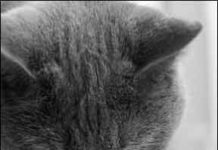The Biggest Mistake in Giving Treats
Treats provide welcome rewards for good behavior, but their overly generous use can contribute to obesity. One reason is that owners don’t count treats as calories. “But the bigger problem is a multiple-person household in which every time someone walks by, they give the cat a treat,” says Joseph Wakshlag, DVM, Ph.D., Associate Professor of Nutrition at the Cornell University College of Veterinary Medicine.
Short Takes: June 2013
Obesity among pets in the U.S. continued to climb in 2012, with the number of overweight cats reaching an all-time high. Veterinarians reported that 58.3 percent of their feline patients — up from 55 percent over the previous year — were overweight or obese in the sixth annual survey by the Association for Pet Obesity Prevention (APOP). Given the cat population of 74.1 million in this country, that equals about 43.2 million cats, the association says. Surprisingly, the survey also revealed a “fat gap,” according to APOP founder Ernie Ward, DVM. When veterinarians asked owners to describe their fat cats’ body condition as too thin, normal, overweight or obese, 45.3 percent said normal.
Easing the Discomfort of GI Sufferers
While the cure for inflammatory bowel disease remains elusive, new strides on the nutritional and pharmaceutical fronts are helping affected cats lead healthier lives. The use of novel or hydrolyzed diets coupled with the administration of the synthetic steroid prednisolone seems to offer an effective one-two therapeutic punch for most cats diagnosed with IBD, says Joseph Wakshlag, DVM, Ph.D., Associate Professor of Clinical Nutrition at the Cornell University College of Veterinary Medicine.
When Weight Loss Is Cause for Alarm
Most owners know that an older feline who has turned into a fat cat may be ill or, at the very least, may have a shorter lifespan than his thinner counterpart. However, owners whose senior cats appear to have lost weight for no discernible reason need to be concerned, too.“If the weight loss in a senior cat is visually apparent, it is time to contact the veterinarian,” says Andrea N. Johnston, DVM, DACVIM, an Instructor in Clinical Sciences at the Cornell University College of Veterinary Medicine. “Weight loss often reflects an underlying disease process, not aging itself.
The Future Basis For Diet Plans: Genetics
Nutritionist Joseph Wakshlag, DVM, Associate Professor of Clinical Nutrition at Cornell University College of Veterinary Medicine, poses a question for owners: “If you knew that your cat would develop cognitive dysfunction at age 12, and if feeding him an antioxidant-enhanced diet would delay that development, wouldn’t you do it?” That scenario may be possible in the not-too-distant future. If scientists identify a gene for feline cognitive dysfunction — and a host of other diseases with genetic risk factors — individualized nutrition and lifestyle plans could be developed for cats based on their genetic tests. It has long been known that nutrition plays an important role in preventing and healing disease in humans, cats and dogs, but its role may be greater than we thought. Researchers in the pioneering science of nutrigenomics stand squarely at the intersection of genetics and nutrition.
Short Takes: July 2012
Lymphoma is the most common cancer diagnosed in cats, and while several prognostic factors have been documented, another factor recently considered to be important is weight loss. Body weight over time may be a simple, objective and useful marker of patient status.
Short Takes: June 2012
Owners often bring their cats to the veterinarian due to a bout of constipation, which can have a variety of causes. Veterinary treatment includes determining and eliminating the cause, if possible, along with medical and sometimes surgical management. Medical therapy often includes the use of laxatives, enemas and prokinetic agents (like cisapride). Psyllium is a soluble fiber that produces a mucilaginous gel that helps to increase fecal bulk. It also adds to stool bulk by other water-holding properties. Psyllium has been found to increase stool frequency and consistency in humans with idiopathic constipation.
Obesity: A Major Health Risk
For the first several years of her life, your cat Tina was slim, agile and remarkably athletic. In the past year or so, however, Tina, formerly light on her feet, has become heavy in her body. You can no longer see or feel her ribs. She seems to have accumulated a pad of fat over her spine, and it even appears that shes developing quite a potbelly.
Understanding Feline Diabetes
A cat’s physical well-being depends largely on the efficiency of its endocrine system, an array of small organs that manufacture chemicals called hormones and deliver them into the animal’s bloodstream. Once they reach their respective target destinations, hormones interact with tissues to enable bodily processes and to ensure their effectiveness. Among the components of the endocrine system is the pancreas — a relatively tiny organ located near a cat’s stomach and small intestine. Perhaps the most important function of the pancreas is the manufacture of a hormone called insulin. After a cat has consumed fats, carbohydrates, and proteins, these dietary components are broken down into a vitally necessary chemical substance called glucose — sometimes referred to as “blood sugar.”
Short Takes: July 2011
Thanks to the development of screening assays and vaccines for FeLV, the prevalence of persistently infected cats has decreased. Recent studies indicate that the FeLV genetic material remains in cats exposed to the virus, though viral replication may not occur. Concern exists that this persistent viral DNA may ultimately contribute to development of lymphoma in cats.
Short Takes: April 2010
Ingestion of foreign bodies - including string-like objects - is a common problem seen in feline veterinary medicine. Foreign bodies may cause partial or complete gastrointestinal (GI) obstruction, which results in disturbances of fluid and electrolyte balance as well as dehydration. Damage to the intestinal tract can also occur. This study ("Gastrointestinal foreign bodies in dogs and cats: a retrospective study of 208 cases" in the Journal of Small Animal Practice, 2009) reviewed the records of 208 cases of GI foreign bodies in dogs and cats that were brought in to the RSPCA Greater Manchester Animal Hospital in the UK from June 2003 to May 2007.
When Your Cat Wont Eat
When a cats food intake drops off, for whatever reason, the resulting decrease in protein intake can trigger feline hepatic lipidosis (FHL), which is the most common form of liver disease in cats. Inadequate protein mobilizes fat from the adipose tissue, and the fat then accumulates in the liver. "Its a vicious cycle," says Ned Kuehn, DVM, MS, a veterinary internist with Michigan Veterinary Specialists in Southfield, Michigan. "When a cat decreases her food intake, more fat accumulates, making the cat feel worse and eat even less. This makes the hepatic lipidosis get worse." The cat becomes anorexic, and severe liver failure occurs - often in as little as a couple of weeks. "Ive seen it happen within a week," says Dr. Kuehn.Some of the Causes. A wide range of conditions can trigger FHL. "About forty percent of cases are due to environmental changes in the house," explains Dr. Kuehn, who is board-certified by the American College of Veterinary Internal Medicine. Triggers include vacations, moving, a new baby, workers in the home, divorce and even teenagers leaving for college. "Cats become stressed and decrease their food intake," says Dr. Kuehn. Illnesses such as diabetes mellitus, hyperthyroidism or cancer; traumatic injury; or the presence of a foreign body in the intestinal tract may also lead to FHL.














